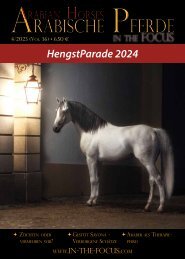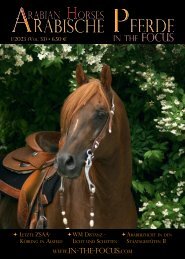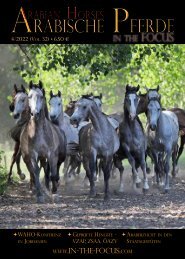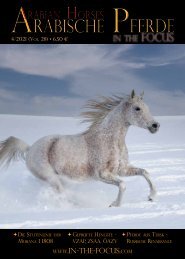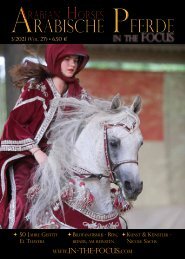Arabische Pferde IN THE FOCUS Nr. 2/2019 - Preview
Zeitschrift für Liebhaber arabischer Pferde
Zeitschrift für Liebhaber arabischer Pferde
Sie wollen auch ein ePaper? Erhöhen Sie die Reichweite Ihrer Titel.
YUMPU macht aus Druck-PDFs automatisch weboptimierte ePaper, die Google liebt.
ist das Konzept so ziemlich dasselbe. Es ist<br />
ein Netzwerk von Experten, die die Glaubwürdigkeit<br />
jedes neuen Blocks (oder <strong>Pferde</strong>s),<br />
welcher der Kette (Stammbaum) hinzugefügt<br />
wurde, aufrechterhalten!<br />
Nehmen wir ein echtes Beduinenbeispiel:<br />
Die folgende Aussage erscheint auf einem<br />
Beduinen-Zertifikat (Hujja) meines Stammes<br />
Tahawi in Ägypten für einen Hengst, den sie<br />
aus Arabien nach Ägypten importiert haben:<br />
"Ein fünfjähriger brauner Hengst, Saqlawi<br />
Jadrani von Ibn Zubaini, gezogen von Ujail<br />
Ibn Jadban, Vater von einem Kuheilan Khadli<br />
von Meqhem Ibn Mehid".<br />
Wie kann ein so kurzer Stammbaum die Referenzen<br />
eines <strong>Pferde</strong>s vollständig festhalten<br />
und wie kann es in vollem Umfang interpretiert<br />
werden?<br />
Bevor wir zeigen, wie dies funktioniert, müssen<br />
wir einige grundlegende Konzepte verstehen,<br />
mit denen es möglich war, einen derart<br />
kompakten und effizienten, aber dennoch<br />
ausreichenden Stammbaum zu führen:<br />
Der Stamm<br />
Der Stamm ist die Hauptidentität des <strong>Pferde</strong>s:<br />
Ein Stamm oder „Rasan“ auf Arabisch sagt viel<br />
aus.<br />
Das Wort "Stamm" ist keine direkte Übersetzung<br />
und bedeutet im Deutschen ursprünglich<br />
etwas anderes als das arabische Wort<br />
Rasan, obwohl beide im selben Kontext verwendet<br />
werden. In der Biologie ist ein Stamm<br />
ein taxonomischer Rang auf niedriger Ebene,<br />
der innerhalb einer Spezies verwendet<br />
wird. Auf Arabisch bedeutet „Rasan“ einfach<br />
„Seil" und wird nur im Zusammenhang mit<br />
arabischen <strong>Pferde</strong>familien verwendet. In der<br />
Tradition der Beduinenzucht werden <strong>Pferde</strong><br />
(mit Seilen) neben dem Zelt angebunden. Da<br />
jede angebundene Stute oftmals eine andere<br />
Familie darstellte, wurde das Seil jeder Stute<br />
als symbolischer Begriff für die Hintergrundinformation<br />
zu der Stute verwendet. Daher<br />
entwickelte sich das Wort Rasan als Äquivalent<br />
zu Stamm (strain).<br />
Obwohl die meisten Beduinenpferde Eigennamen<br />
trugen, waren Namen für die Abstammung<br />
nicht erforderlich, und der Stammname<br />
war die Schlüsselkennung. Der Stamm wird<br />
immer von der Mutterseite geerbt. Die Mutter<br />
definiert also die Familie, nicht der Vater. Der<br />
Stamm wird als ausreichend angesehen, um<br />
die vollständige Linie eines arabischen <strong>Pferde</strong>s<br />
(weibliche Stutenlinie) anzuzeigen.<br />
Beispiele für Stämme sind Kuheilan, Dahman,<br />
Saqlawi, Hadban usw. Es gibt eine große Diskussion<br />
darüber, wie und wann sich Stämme<br />
entwickelt haben und was sie wirklich bedeuten.<br />
Dies wurde in einem früheren Artikel<br />
(siehe AP 1/<strong>2019</strong>) dargelegt. Ein weiterer<br />
Artikel von Joe Ferriss trägt den Titel "Arabian<br />
Horse Strains" (<strong>Arabische</strong> <strong>Pferde</strong>stämme)<br />
und enthält Beispiele. Die Studie klärt über<br />
den westlichen Mythos auf, dass bestimmte<br />
Phänotypen an bestimmte Stämme gebunden<br />
seien.<br />
(https://www.pyramidsociety.org/sites/default/files/ferriss_strainhandoutsgs_0.pdf)<br />
2/<strong>2019</strong> - www.in-the-focus.com<br />
Saqlawi Jadrani, imp.<br />
1935 aus Syrien von<br />
den Shammar Beduinen.<br />
Das Foto wurde<br />
1945 aufgenommen,<br />
und zeigt Mohammed<br />
Otham Abdullah Saoud<br />
Al-Tahawi.<br />
Saqlawi Jadrani, imp.<br />
1935 from Syria from the<br />
Shammar tribe. The picture<br />
was taken in 1945<br />
and appearing Mohammed<br />
Otham Abdullah<br />
Saoud Al-Tahawi.<br />
This multi-generation pedigree was developed<br />
in the West based on the availability<br />
of detailed records either on paper<br />
or in computer databases. A pedigree of<br />
five generations includes 65 different horse<br />
names. Adding the other information such<br />
as color, date of birth, breeder...etc, information<br />
explodes and becomes impossible<br />
to maintain without comprehensive records.<br />
How did the Bedouins in the desert keep<br />
the pedigrees of their horses? We know how<br />
purity mattered to the Bedouins and how<br />
sacred it meant to them from cultural and<br />
religious perspectives. They must have developed<br />
their methods of tracking linages<br />
and maintaining the Asil credentials of their<br />
horses. They were definitely not less keen on<br />
this than modern studbooks. But how did<br />
this work?<br />
The Bedouins had more compact and easy<br />
to memorize form of pedigrees that did not<br />
require more than ten to fifteen pieces of<br />
information at most and still provide sufficient<br />
details to establish a horse identity and<br />
credentials! There is no magic but it is rather<br />
a kind of abstraction where few classes of<br />
information were considered more significant<br />
than many irrelevant details, and were<br />
deemed sufficient for identity verification<br />
within a surrounding network of “registrars”<br />
or pedigree keepers! It reminds me as an IT<br />
professional with the BlockChain technology<br />
used in the famous crypto-currency<br />
known as BitCoin! Funny enough the concept<br />
is pretty much the same. It is a network<br />
of registrars who maintain the credibility of<br />
every new block (horse) added to the chain<br />
(pedigree)!<br />
Let us take a real Bedouin example. The following<br />
statement appears on a Bedouin certificate<br />
(Hujja) belonging to my Tahawi Tribe<br />
in Egypt for a stallion they imported from<br />
Arabia to Egypt:<br />
"A five year, bay, stallion, Saqlawi Jadraini of<br />
Ibn Zubaini, bred by Ujail Ibn Jadban, sired<br />
by a Kuheilan Khadli of Meqhem Ibn Mehid".<br />
How can such short pedigree fully establish<br />
the credential of a horse and how can it be<br />
interpreted to the fullest?<br />
Before we show how this works we need to<br />
understand a couple of basic concepts upon<br />
which it was possible to maintain such compact<br />
and efficient but yet sufficient pedigree:<br />
51<br />
The Strain<br />
Strain is the main horse identity: A strain or<br />
“Rasan” in Arabic tells a lot by itself.<br />
The word strain is not a direct translation,<br />
and originally means different thing in English<br />
than the Arabic word Rasan although<br />
both used in the same context. In biology,<br />
a strain is a low-level taxonomic rank used<br />
within a species. In Arabic “Rasan” simply<br />
means robe and is used in the context of<br />
Arabian Horse families only. In the Bedouin<br />
breeding traditions horses are tied (by robes)<br />
around the tent. As each tied mare often represented<br />
a different family the robe of each<br />
mare was used as a symbolic notion for the<br />
mare background. Hence the word Rasan<br />
developed as the equivalent of Strain.<br />
Although most of the Bedouin horses carried<br />
proper names but names were not necessary<br />
in pedigree keeping, and strain name was<br />
the key identifier. Strain is always inherited<br />
from the dam side. So the mother is what defines<br />
the family not the father. The strain is<br />
considered sufficient to indicate the full line<br />
of an Arabian Horse (tail female line).<br />
Examples for strains include Kuheilan, Dahman,<br />
Saqlawi, Hadban… etc. It is a big discussion<br />
how and when did strains develop<br />
and what they truly mean, which was discussed<br />
in a previous article by the writer published<br />
here and on Al Khamsa organization<br />
magazine. Another study by Joe Ferriss is<br />
titled “Arabian Horse Strains” with examples<br />
and real stories is published on the Pyramids<br />
Society web site. The study clears the Western<br />
myth that certain phenotypes are attached<br />
to specific Arabian Horse strains.<br />
The Marbat<br />
Marbat is the physical location where horses<br />
are kept. The area where all mares of a Bedouin<br />
breeder are tied is called the tying area,<br />
or “Marbat” in Arabic, which is equivalent to<br />
stud or horse farm in English. The Marbat is<br />
nothing but a set of Rasans (set of robes or tied<br />
mares.) It is significant how robes and tying (or<br />
hobbling) are very evident in this terminology.<br />
Hobbling is viewed negatively in the Western<br />
perceptions but was a necessity in the desert<br />
and did not seem to inhibit the Arabian Horse<br />
qualities of mind and character.<br />
The use of strains in the daily practice of<br />
the Bedouin was usually attached with the<br />
Geschichte und Tradition



